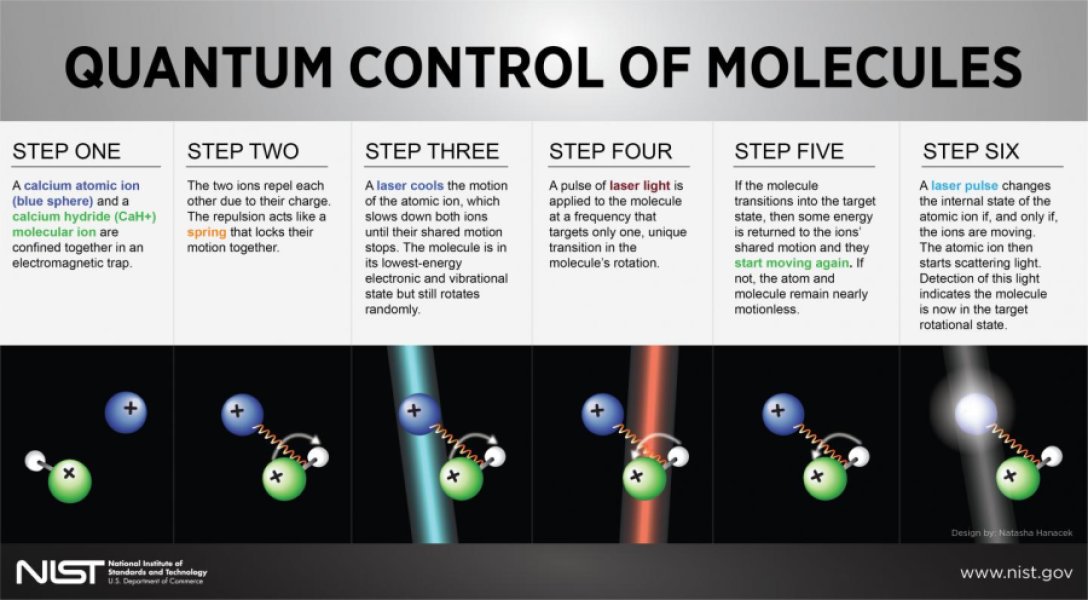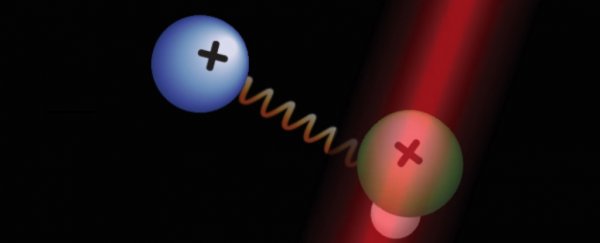The world's most accurate timekeepers have brought their powers to bear on the next leap in quantum research - moving from quantum control of single atoms to entire molecules.
This step up in manipulating something more complex than atoms could offer new options in how we might store or convert quantum information, or even allow us to probe for answers on some of physics' deepest secrets.
To make ridiculously accurate atomic clocks that barely lose or gain a second in several billion years, you need to control the quantum nature of atoms.
The US National Institute of Standards and Technology (NIST) does just that by trapping bunches of caesium, strontium, or ytterbium atoms, and cooling them down to as close to absolute zero as possible by smacking them with a well-timed laser.
Once they're sitting rather still, it's a matter of exposing the atoms to a frequency of radiation that causes their electrons to move back and forth between certain energy states, producing the 'tick-tock' of the clock.
While it's a bit more complicated in reality, manipulating atoms is relative child's play when they're not all bound together. Once their charges are all tied up in molecules, it becomes a bit harder to probe and control their quantum properties.
One way to do it is to borrow an idea from a type of quantum logic clock, which traps a single aluminium ion in an electric field and makes it hum with ultra-violet radiation. As stable as it is when it comes to ticking its tocks, aluminium isn't the friendliest element when it comes to being controlled.
To control it all, the aluminium ion is married to another positively charged ion, such as magnesium; hitting the magnesium with a laser will cool it down, while the fact both are positively charged means it will nudge the aluminium, slowing it down as well.
The "quantum logic" part of this clock refers to the quantum properties of the aluminium being transferred to its partner, which shares the information in the form of a unique binary signal that can be detected.
While the same concept has been applied to molecules before using complex equipment arranged to probe for single properties, researchers at NIST have now developed a more general protocol that can be applied to a wider range of conditions.
Following the same basic idea, the scientists contained a pair of calcium ions in an ion trap they happened to have lying around after an old teleportation experiment. Yes, really.
They then leaked in hydrogen gas until just one of the ions snapped up a proton and became a molecule of calcium hydride, or CaH+.
Since they were both positively charged and sitting side by side, the movements of the calcium ion affected the movements of the calcium hydride as if there was a spring between them.
Cooling the calcium ion with a laser put its electrons into their lowest energy state and slowed its jiggling. In turn this put the calcium hydride molecule's electrons into their lowest energy state as well, and also slowed its jiggling.
This allowed researchers to poke the molecule in some way that would have it 'tell' the atom something about its quantum state that couldn't be determined directly, which is then communicated with a signal.
"Whatever trick you can play with atomic ions is now within reach with molecular ions. Now the molecule will 'listen' to you – asking, in effect, 'What do you want me to do?'" said NIST physicist James Chinwen Chou.
The type of manipulation would be chosen to provoke a response only if the molecule was in a specific quantum state, resulting in the translating atom giving a simple binary answer.
Consider for example if the molecule is chilled into its lowest energy state and lowest vibration, it can still rotate randomly.
If you want to know something about its rotational position, you could hit it with a laser set at a frequency that would target a specific transition in its rotation.
If it spins into the target position, some leftover energy makes the molecule jiggle.
"The molecule only jiggles if it is in the right state. The atom feels that jiggle and can transfer the jiggle into a light signal we can pick up," said researcher Dietrich Leibfried.
Leibfried likens the whole arrangement to braille, which is like feeling the information rather than seeing it.
Maybe it can also be likened to playing a game of 20 questions with magicians Penn and Teller, where Penn communicates "yes" or "no" on his silent partner's behalf.
If you're still a little confused – and let's face it, when it comes to quantum mechanics and weird analogies, who can blame you – this diagram below might help make some sense of the research.
 Hanacek/NIST
Hanacek/NIST
But being able to chill and control atoms has opened up a world of high precision measurements and amazing potential in information technology.
Scaling up to whole molecules could pave the way for similar opportunities.
"This is part of NIST's basic mission, to develop precision measurement tools that maybe other people can use in their work," said Leibfried.
This research has been published in Nature.
